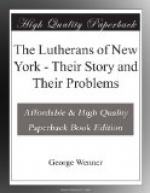“In the second place, our Committee has injected into the general Reformation influence the question of the wider influence of the Reformation. Practically every section of the country has taken up the discussion of the religious influence of the Reformation, also of the influence of the Reformation on every side of life.”
On the roll of Former Pastors, in the Appendix, are recorded the names of men who laid the foundations of the present congregations. Their labors and their sacrifices entitle them to a place in a book of remembrance. Some names are missing. We tried hard to obtain them. For these lacunae we offer our apologies to the historians of the next centennial. In 1918 we were still struggling with the problem of statistics.
Nowhere are ministers forgotten so soon as here in
New York. The congregations themselves are rapidly
engulphed in the ceaseless tides of humanity that
sweep over the island. Now and then some beloved
pastor is remembered by some faithful friends, but
in a few years the very names of the men who built
the churches are forgotten. Like the knights
of old:
“Their swords are rust,
Their steeds are dust.
Their souls are with the saints
we trust.”
Before ending the story of which a faint outline has here been given, we recall with affection and reverence some of the men whose outstanding personality has not yet faded from our memory. Their labors prepared the ground for the harvests which a younger generation is now permitted to reap.
Stohlmann was the connecting link with the earlier periods. He was an able preacher, a warm hearted pastor and a conscientious man.
Geissenhainer, the pastor of St. Paul’s, which he organized in 1841 after having been an assistant of his father in St. Matthew’s since 1826, was another connecting link with the past.
Held of St. John’s was a pupil of Claus Harms. His eloquent sermons attracted great congregations to Christopher Street.
After fourteen fruitful years in St. James’ Church, Wedekind was called to Christopher Street in November, 1878, to succeed Pastor Held. Here he labored for twelve years, edifying the church and inspiring St. John’s to bcome one of our most efficient congregations. Under his direction at least four young men of the congregation were led into the ministry. He died April 8, 1897.
[illustration: “Augustus Charles Wedekind, D.D.”]
Under a quiet exterior Krotel concealed a forceful personality. He was a born leader and took a large part in the development of the General Council. As editor of the Lutherischer Herold for three years and of The Lutheran for many years his writings had a wide influence. From 1868 to 1895 he was pastor of Holy Trinity Church. In 1896, in the 71st year of his age, he accepted a call to the newly organized Church of the Advent, which he served until his death on May 17th, 1907. Under the pen name of Insulanus he delighted the readers of The Lutheran for forty years with his reflections on men and things in New York. Among his published works are a Life of Melanchthon, Meditations on the Beatitudes and Explanations of Luther’s Catechism.




